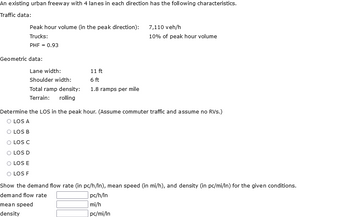
Structural Analysis
6th Edition
ISBN: 9781337630931
Author: KASSIMALI, Aslam.
Publisher: Cengage,
expand_more
expand_more
format_list_bulleted
Question
An existing urban freeway with 4 lanes in each direction has the following characteristics.
Traffic data:
Peak hour volume (in the peak direction):
7,110 veh/h
Trucks:
10% of peak hour volume
PHF = 0.93
Geometric data:
Lane width:
11 ft
Shoulder width:
6 ft
Total ramp density:
1.8 ramps per mile
Terrain:
rolling
Determine the LOS in the peak hour. (Assume commuter traffic and assume no RVs.)
LOS A LOS B LOS C LOS D LOS E LOS F
Show the demand flow rate (in pc/h/ln), mean speed (in mi/h), and density (in pc/mi/ln) for the given conditions.
demand flow rate pc/h/lnmean speed mi/h density pc/mi/ln

Transcribed Image Text:An existing urban freeway with 4 lanes in each direction has the following characteristics.
Traffic data:
Peak hour volume (in the peak direction): 7,110 veh/h
Trucks:
PHF = 0.93
Geometric data:
Lane width:
Shoulder width:
Total ramp density:
Terrain: rolling
11 ft
6 ft
1.8 ramps per mile
10% of peak hour volume
Determine the LOS in the peak hour. (Assume commuter traffic and assume no RVS.)
O LOS A
O LOS B
O LOS C
LOS D
O LOS E
O LOS F
Show the demand flow rate (in pc/h/In), mean speed (in mi/h), and density (in pc/mi/ln) for the given conditions.
demand flow rate
pc/h/In
mean speed
mi/h
density
pc/mi/In
Expert Solution
This question has been solved!
Explore an expertly crafted, step-by-step solution for a thorough understanding of key concepts.
This is a popular solution
Trending nowThis is a popular solution!
Step by stepSolved in 5 steps

Knowledge Booster
Learn more about
Need a deep-dive on the concept behind this application? Look no further. Learn more about this topic, civil-engineering and related others by exploring similar questions and additional content below.Similar questions
- which type of urban road would have free-flow traffic characteristics? 1. Arterial 2. Local 3. Freeway 4. Collectorarrow_forwardA 5% upgrade on a six-lane freeway (three lanes in each direction) is 1.25 mi long. On this segment of freeway, there is 3% SUTS and 7% TTs, and the peak-hour factor is 0.90. The lanes are 12 ft wide, there are no lateral obstructions within 6 ft of the roadway, and the total ramp density is 1.0 ramps per mile. What is the maximum directional peak-hour volume that can be accommodated without exceeding LOS C operating conditions in veh/h? Round of your answer to whole number. Blank 1arrow_forwardDetermine the value of PTSF for a 6-mile two-lane highway in rolling terrain. Traffic data are as follows: • Volume = 1600 veh/h (two-way) • Percent trucks = 14% • Percent RVs = 4% • Peak hour factor = 0.95 • Percent directional split = 50 - 50 • Percent no-passing zones = 50arrow_forward
- Problem 2. New freeway is being designed on a level terrain, free-flow speed 70 mph 12-ft lanes, 6-ft lateral clearance Peak hour volume 2700 veh, 12% heavy vehicles PHF = 0.92 FIND: Number of lanes for LOS Carrow_forwardIf Vf = 2327 VPH with 9% trucks, VR1 = 653 VPH with 5% trucks, and VR2 = 594 VPH with 8% trucks, what is the passenger car equivalents (Vpcph) of the onramp? Assume that the roadway is urban.arrow_forward(PLEASE USE FIGURE 14.5 TO ANSWER THE QUESTION) A consecutive upgrade consists of two sections, the first of 2 percent grade and 5000 ft long, and the second of 6 percent grade and 5000 ft long. Trucks comprise 10 percent of traffic. And recreational vehicles comprise 6 percent. Determine: the equivalent grade the PCEsarrow_forward
arrow_back_ios
arrow_forward_ios
Recommended textbooks for you

 Structural Analysis (10th Edition)Civil EngineeringISBN:9780134610672Author:Russell C. HibbelerPublisher:PEARSON
Structural Analysis (10th Edition)Civil EngineeringISBN:9780134610672Author:Russell C. HibbelerPublisher:PEARSON Principles of Foundation Engineering (MindTap Cou...Civil EngineeringISBN:9781337705028Author:Braja M. Das, Nagaratnam SivakuganPublisher:Cengage Learning
Principles of Foundation Engineering (MindTap Cou...Civil EngineeringISBN:9781337705028Author:Braja M. Das, Nagaratnam SivakuganPublisher:Cengage Learning Fundamentals of Structural AnalysisCivil EngineeringISBN:9780073398006Author:Kenneth M. Leet Emeritus, Chia-Ming Uang, Joel LanningPublisher:McGraw-Hill Education
Fundamentals of Structural AnalysisCivil EngineeringISBN:9780073398006Author:Kenneth M. Leet Emeritus, Chia-Ming Uang, Joel LanningPublisher:McGraw-Hill Education
 Traffic and Highway EngineeringCivil EngineeringISBN:9781305156241Author:Garber, Nicholas J.Publisher:Cengage Learning
Traffic and Highway EngineeringCivil EngineeringISBN:9781305156241Author:Garber, Nicholas J.Publisher:Cengage Learning


Structural Analysis (10th Edition)
Civil Engineering
ISBN:9780134610672
Author:Russell C. Hibbeler
Publisher:PEARSON

Principles of Foundation Engineering (MindTap Cou...
Civil Engineering
ISBN:9781337705028
Author:Braja M. Das, Nagaratnam Sivakugan
Publisher:Cengage Learning

Fundamentals of Structural Analysis
Civil Engineering
ISBN:9780073398006
Author:Kenneth M. Leet Emeritus, Chia-Ming Uang, Joel Lanning
Publisher:McGraw-Hill Education


Traffic and Highway Engineering
Civil Engineering
ISBN:9781305156241
Author:Garber, Nicholas J.
Publisher:Cengage Learning